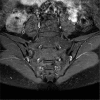Progressive sacroiliitis due to accessory sacroiliac joint mimicking ankylosing spondylitis: A case report
- PMID: 31008988
- PMCID: PMC6494240
- DOI: 10.1097/MD.0000000000015324
Progressive sacroiliitis due to accessory sacroiliac joint mimicking ankylosing spondylitis: A case report
Abstract
Rationale: An accessory sacroiliac (SI) joint usually has little clinical significance. However, severe arthritic changes can cause chronic buttock or low back pain and can be misdiagnosed as another disease presenting with sacroiliitis such as ankylosing spondylitis (AS).
Patient concerns: A 33-year-old woman was diagnosed with AS due to chronic buttock pain and progressive sacroiliitis on plain X-ray and magnetic resonance imaging (MRI). Her buttock and low back pain gradually worsened despite proper treatment for AS.
Diagnosis: Computed tomography revealed an accessory SI joint with arthritic changes.
Interventions: Nonsteroidal anti-inflammatory drugs (NSAIDs) and restricted movement were prescribed.
Outcomes: The symptoms were controlled with NSAIDs, rest, and restriction of excessive movement. The medication could be stopped after the pain subsided.
Lessons: An accessory SI joint can be a cause of chronic back pain and can be misdiagnosed as AS with sacroiliitis when progressive arthritic changes are observed. Therefore, additional imaging studies other than conventional X-ray or MRI may be required for accurate diagnosis.
Conflict of interest statement
The authors have no conflicts of interest to disclose.
Figures



Similar articles
-
Sponyloarthritis features forecasting the presence of HLA-B27 or sacroiliitis on magnetic resonance imaging in patients with suspected axial spondyloarthritis: results from a cross-sectional study in the ESPeranza Cohort.Arthritis Res Ther. 2015 Sep 23;17(1):265. doi: 10.1186/s13075-015-0779-y. Arthritis Res Ther. 2015. PMID: 26395086 Free PMC article.
-
Value of multidetector computed tomography for the radiologic grading of sacroiliitis in ankylosing spondylitis.Rheumatol Int. 2013 Apr;33(4):1005-11. doi: 10.1007/s00296-012-2450-0. Epub 2012 Aug 4. Rheumatol Int. 2013. PMID: 22865054
-
Imaging of sacroiliac joints in patients with acromegaly.Sci Rep. 2019 Aug 12;9(1):11645. doi: 10.1038/s41598-019-48250-w. Sci Rep. 2019. PMID: 31406221 Free PMC article.
-
Imaging of sacroiliitis.Clin Rheumatol. 2000;19(1):51-7. doi: 10.1007/s100670050011. Clin Rheumatol. 2000. PMID: 10752500 Review.
-
Imaging the Patient With Sacroiliac Pain.Can Assoc Radiol J. 2016 Feb;67(1):41-51. doi: 10.1016/j.carj.2015.08.001. Epub 2015 Nov 26. Can Assoc Radiol J. 2016. PMID: 26632100 Review.
Cited by
-
Influence of sacroiliac joint variation on clinical features of axial spondyloarthritis: a comparative analysis.RMD Open. 2025 Feb 8;11(1):e004923. doi: 10.1136/rmdopen-2024-004923. RMD Open. 2025. PMID: 39922705 Free PMC article.
-
Etiopathogenesis of sacroiliitis: implications for assessment and management.Korean J Pain. 2020 Oct 1;33(4):294-304. doi: 10.3344/kjp.2020.33.4.294. Korean J Pain. 2020. PMID: 32989194 Free PMC article. Review.
-
Prevalence of accessory sacroiliac joint anatomy and associated clinical features.Skeletal Radiol. 2023 Jul;52(7):1359-1368. doi: 10.1007/s00256-023-04281-z. Epub 2023 Jan 16. Skeletal Radiol. 2023. PMID: 36642769 Free PMC article.
-
Novel insights into the anatomy and histopathology of the sacroiliac joint and correlations with imaging signs of sacroiliitis in case of axial spondyloarthritis.Front Physiol. 2023 May 11;14:1182902. doi: 10.3389/fphys.2023.1182902. eCollection 2023. Front Physiol. 2023. PMID: 37250138 Free PMC article. Review.
References
-
- Hadley LA. Accessory sacro-iliac articulations. J Bone Joint Surg Am 1952;34-A:149–55. - PubMed
-
- Rosa Neto NS, Vitule LF, Goncalves CR, et al. An accessory sacroiliac joint. Scand J Rheumatol 2009;38:496. - PubMed
-
- Prassopoulos PK, Faflia CP, Voloudaki AE, et al. Sacroiliac joints: anatomical variants on CT. J Comput Assist Tomogr 1999;23:323–7. - PubMed
-
- van der Linden S, Valkenburg HA, Cats A. Evaluation of diagnostic criteria for ankylosing spondylitis. A proposal for modification of the New York criteria. Arthritis Rheum 1984;27:361–8. - PubMed
-
- Rudwaleit M, van der Heijde D, Landewe R, et al. The development of Assessment of SpondyloArthritis international Society classification criteria for axial spondyloarthritis (part II): validation and final selection. Ann Rheum Dis 2009;68:777–83. - PubMed
Publication types
MeSH terms
LinkOut - more resources
Full Text Sources
Medical
Research Materials

